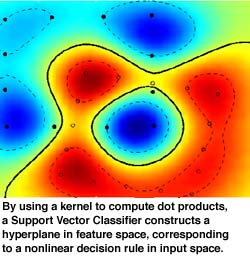KALIF - Kernel Algorithms for Learning in Feature Spaces
by Bernhard Schölkopf
Kernel Algorithms represent a novel means for nonlinear analysis
of complex real-world data. By providing a mathematical foundation
for previous algorithms such as Neural Nets, they support systematic
and principled improvements of learning algorithms for pattern
recognition, function estimation, and feature extraction.
Learning algorithms are particularly useful in situations where
an empirically observable dependency cannot be modelled explicitly,
but ample empirical data are available. Examples thereof include
pattern recognition problems ranging from pedestrian or traffic
sign detection via internet text categorization to problems of
financial time series analysis.
The KALIF project (Kernel Algorithms for Learning in Feature Spaces)
develops and applies statistical methods for data analysis in
nonlinear feature spaces. One can show that a certain class of
kernel functions computes dot products in high-dimensional feature
spaces nonlinearly related to input space. This way, a number
of learning algorithms that can be cast in terms of dot products
can implicitly be carried out in feature spaces - without the
need for complex calculations in these high-dimensional spaces.

An example thereof are Support Vector methods for classification
(see Figure) and regression. Moreover, we have recently generalized
a standard algorithm for high-dimensional data analysis, the algorithm
of statistical principal component analysis (PCA), to the nonlinear
case. To this end, we carry out standard linear PCA in the feature
space, using kernels. The algorithms boils down to a matrix diagonalization.
It can, for instance, be used for nonlinear feature extraction
and dimensionality reduction.
It is precisely the close encounter of theory and practice that
renders this recently emerging research area particularly appealing:
using complexity concepts of statistical learning theory and methods
of functional analysis, we can now theoretically analyze and further
develop a number of successful heuristical methods of data analysis.
This has already led to record results on several benchmark problems,
such as the digit recognition database of the American National
Institute of Standards and Technology (NIST).
Potentially more important, however, is the fact that the increased
accuracy of these algorithms helps opening up new application
fields, which previously had not been accessible to machine learning
such as, for instance, very high-dimensional data sets.
More information at: http://svm.first.gmd.de/kalif.html
Please contact:
Bernhard Schölkopf - GMD
Tel: +49 30 6392 1875
E-mail: bs@first.gmd.de
Klaus-Robert Müller - GMD
Tel:+49 30 6392 1860
E-mail: klaus@first.gmd.de
